BCO5501 - Business Process Engineering: BPM Research Report Analysis
VerifiedAdded on 2022/09/16
|11
|2819
|13
Report
AI Summary
This report provides an in-depth analysis of Business Process Engineering (BPE), focusing on Business Process Management (BPM) and its evolution in response to technological innovations. The report begins with an introduction that highlights the growing impact of digital technologies on traditional business practices and then compares and contrasts various perspectives within BPM, including the shift from mass production to quality-focused manufacturing and the impact of computerization and globalization. The analysis covers the importance of customer satisfaction, the need for organizations to adapt to technological advancements, and the different stages of BPM, such as design, modeling, and monitoring. The report concludes by summarizing the key points discussed, emphasizing the necessity for organizations to continually improve their business processes to remain competitive. The report is based on research from the 14th-16th International Conference on Business Process Management (BPM). The report also addresses the challenges and opportunities presented by technological advancements and changing market dynamics.
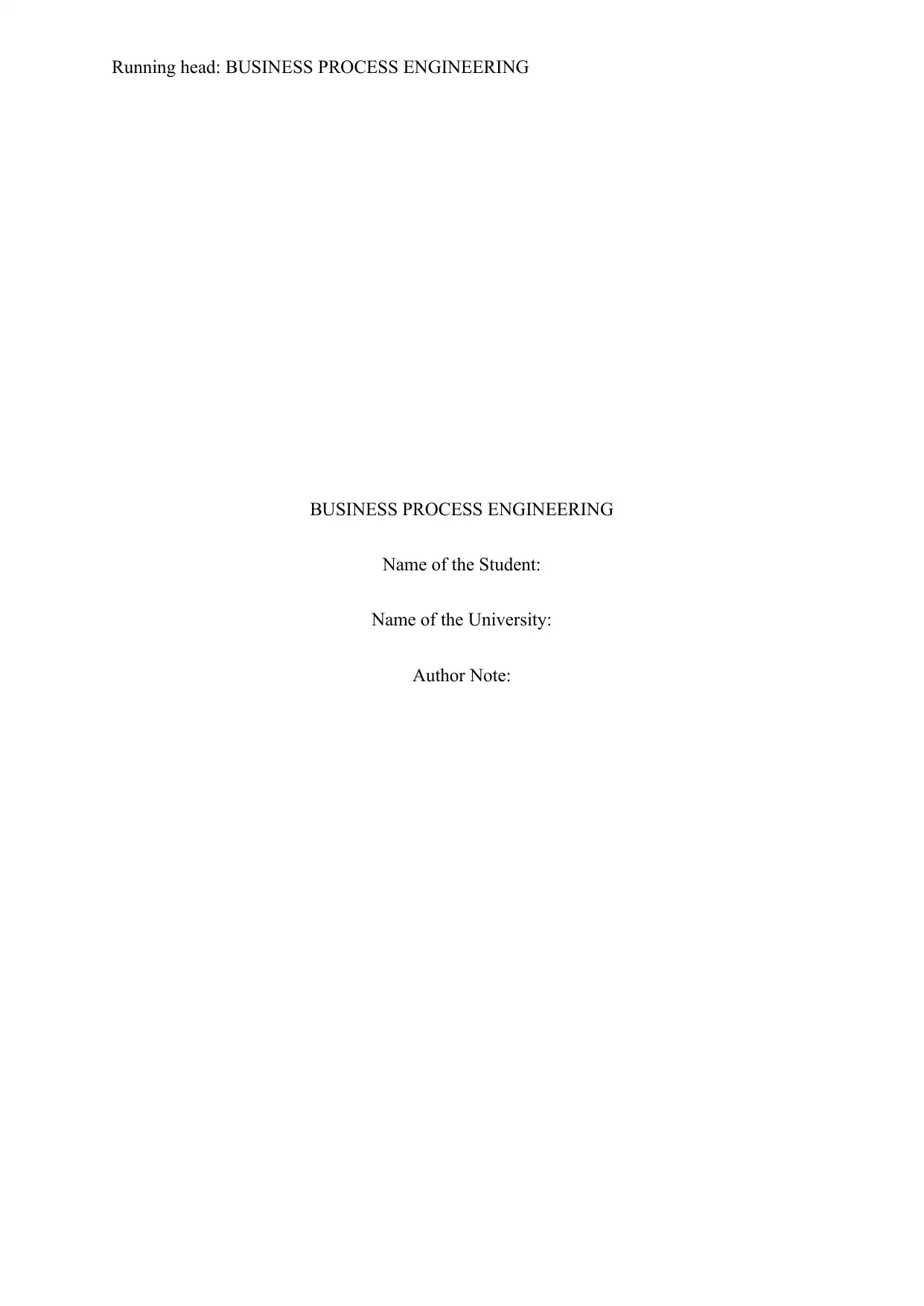
Running head: BUSINESS PROCESS ENGINEERING
BUSINESS PROCESS ENGINEERING
Name of the Student:
Name of the University:
Author Note:
BUSINESS PROCESS ENGINEERING
Name of the Student:
Name of the University:
Author Note:
Paraphrase This Document
Need a fresh take? Get an instant paraphrase of this document with our AI Paraphraser

1
BUSINESS PROCESS ENGINEERING
Table of Contents
Introduction................................................................................................................................2
Comparison and Contrast of BPM.............................................................................................2
Conclusion..................................................................................................................................7
References..................................................................................................................................9
BUSINESS PROCESS ENGINEERING
Table of Contents
Introduction................................................................................................................................2
Comparison and Contrast of BPM.............................................................................................2
Conclusion..................................................................................................................................7
References..................................................................................................................................9
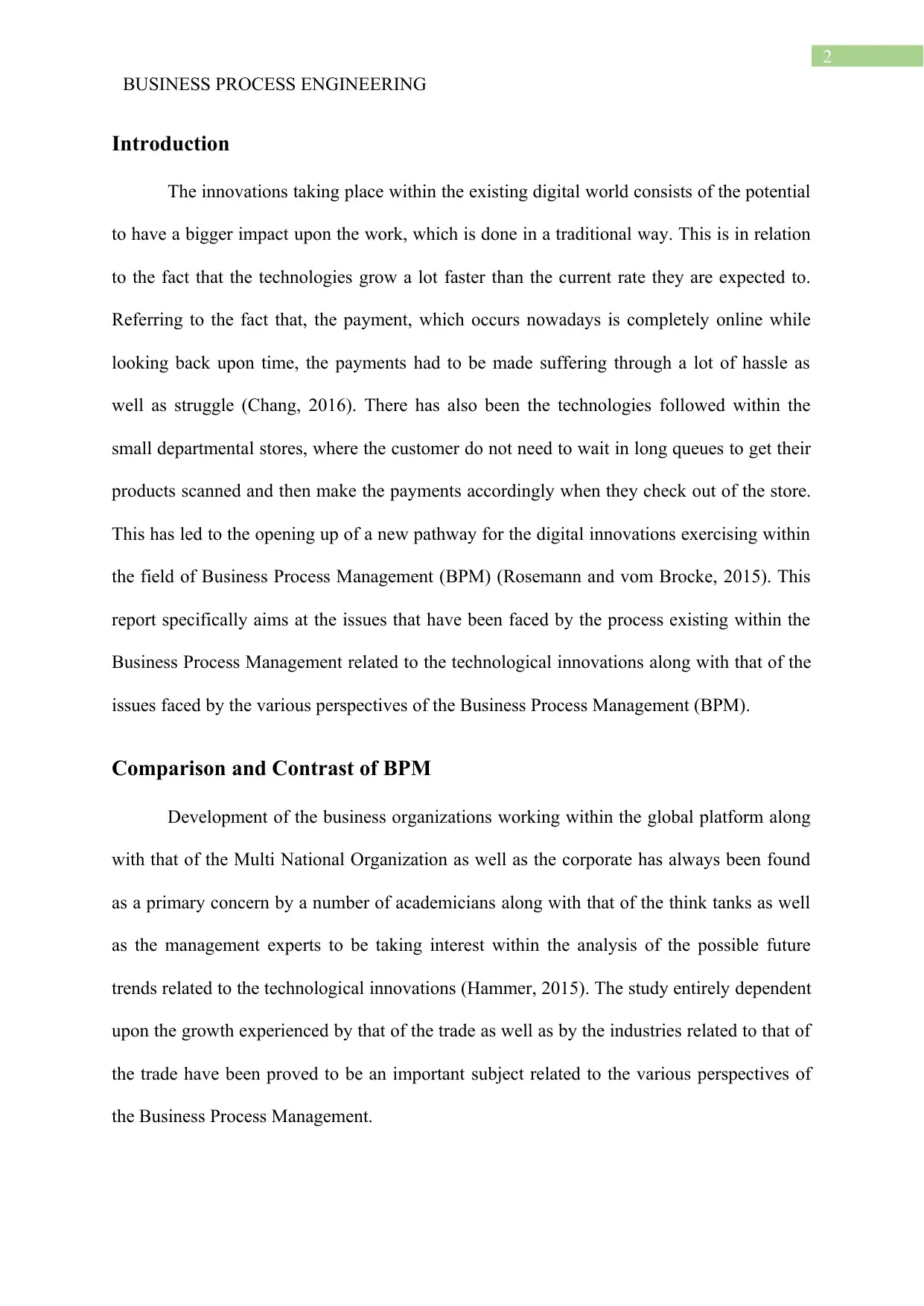
2
BUSINESS PROCESS ENGINEERING
Introduction
The innovations taking place within the existing digital world consists of the potential
to have a bigger impact upon the work, which is done in a traditional way. This is in relation
to the fact that the technologies grow a lot faster than the current rate they are expected to.
Referring to the fact that, the payment, which occurs nowadays is completely online while
looking back upon time, the payments had to be made suffering through a lot of hassle as
well as struggle (Chang, 2016). There has also been the technologies followed within the
small departmental stores, where the customer do not need to wait in long queues to get their
products scanned and then make the payments accordingly when they check out of the store.
This has led to the opening up of a new pathway for the digital innovations exercising within
the field of Business Process Management (BPM) (Rosemann and vom Brocke, 2015). This
report specifically aims at the issues that have been faced by the process existing within the
Business Process Management related to the technological innovations along with that of the
issues faced by the various perspectives of the Business Process Management (BPM).
Comparison and Contrast of BPM
Development of the business organizations working within the global platform along
with that of the Multi National Organization as well as the corporate has always been found
as a primary concern by a number of academicians along with that of the think tanks as well
as the management experts to be taking interest within the analysis of the possible future
trends related to the technological innovations (Hammer, 2015). The study entirely dependent
upon the growth experienced by that of the trade as well as by the industries related to that of
the trade have been proved to be an important subject related to the various perspectives of
the Business Process Management.
BUSINESS PROCESS ENGINEERING
Introduction
The innovations taking place within the existing digital world consists of the potential
to have a bigger impact upon the work, which is done in a traditional way. This is in relation
to the fact that the technologies grow a lot faster than the current rate they are expected to.
Referring to the fact that, the payment, which occurs nowadays is completely online while
looking back upon time, the payments had to be made suffering through a lot of hassle as
well as struggle (Chang, 2016). There has also been the technologies followed within the
small departmental stores, where the customer do not need to wait in long queues to get their
products scanned and then make the payments accordingly when they check out of the store.
This has led to the opening up of a new pathway for the digital innovations exercising within
the field of Business Process Management (BPM) (Rosemann and vom Brocke, 2015). This
report specifically aims at the issues that have been faced by the process existing within the
Business Process Management related to the technological innovations along with that of the
issues faced by the various perspectives of the Business Process Management (BPM).
Comparison and Contrast of BPM
Development of the business organizations working within the global platform along
with that of the Multi National Organization as well as the corporate has always been found
as a primary concern by a number of academicians along with that of the think tanks as well
as the management experts to be taking interest within the analysis of the possible future
trends related to the technological innovations (Hammer, 2015). The study entirely dependent
upon the growth experienced by that of the trade as well as by the industries related to that of
the trade have been proved to be an important subject related to the various perspectives of
the Business Process Management.
⊘ This is a preview!⊘
Do you want full access?
Subscribe today to unlock all pages.

Trusted by 1+ million students worldwide
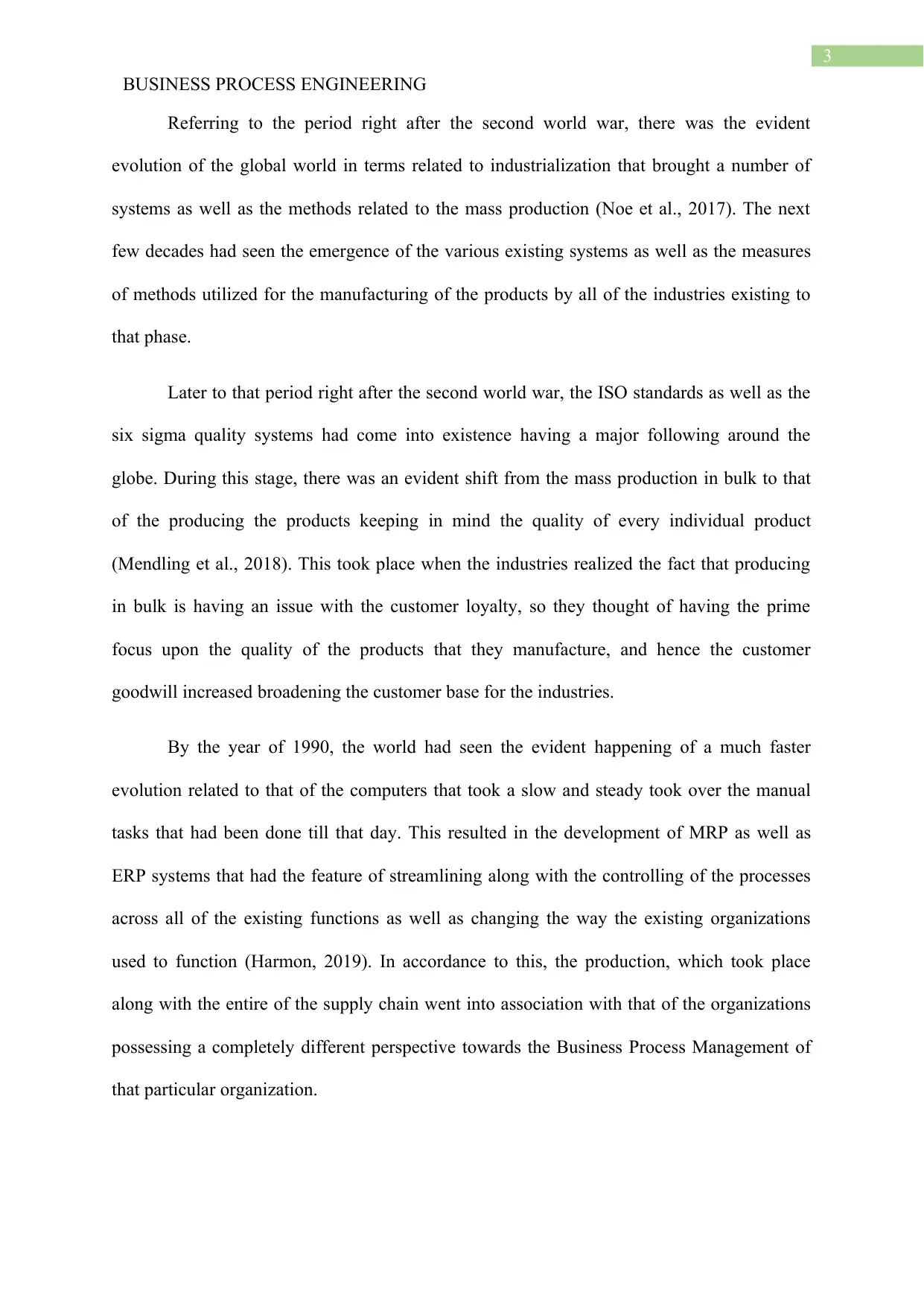
3
BUSINESS PROCESS ENGINEERING
Referring to the period right after the second world war, there was the evident
evolution of the global world in terms related to industrialization that brought a number of
systems as well as the methods related to the mass production (Noe et al., 2017). The next
few decades had seen the emergence of the various existing systems as well as the measures
of methods utilized for the manufacturing of the products by all of the industries existing to
that phase.
Later to that period right after the second world war, the ISO standards as well as the
six sigma quality systems had come into existence having a major following around the
globe. During this stage, there was an evident shift from the mass production in bulk to that
of the producing the products keeping in mind the quality of every individual product
(Mendling et al., 2018). This took place when the industries realized the fact that producing
in bulk is having an issue with the customer loyalty, so they thought of having the prime
focus upon the quality of the products that they manufacture, and hence the customer
goodwill increased broadening the customer base for the industries.
By the year of 1990, the world had seen the evident happening of a much faster
evolution related to that of the computers that took a slow and steady took over the manual
tasks that had been done till that day. This resulted in the development of MRP as well as
ERP systems that had the feature of streamlining along with the controlling of the processes
across all of the existing functions as well as changing the way the existing organizations
used to function (Harmon, 2019). In accordance to this, the production, which took place
along with the entire of the supply chain went into association with that of the organizations
possessing a completely different perspective towards the Business Process Management of
that particular organization.
BUSINESS PROCESS ENGINEERING
Referring to the period right after the second world war, there was the evident
evolution of the global world in terms related to industrialization that brought a number of
systems as well as the methods related to the mass production (Noe et al., 2017). The next
few decades had seen the emergence of the various existing systems as well as the measures
of methods utilized for the manufacturing of the products by all of the industries existing to
that phase.
Later to that period right after the second world war, the ISO standards as well as the
six sigma quality systems had come into existence having a major following around the
globe. During this stage, there was an evident shift from the mass production in bulk to that
of the producing the products keeping in mind the quality of every individual product
(Mendling et al., 2018). This took place when the industries realized the fact that producing
in bulk is having an issue with the customer loyalty, so they thought of having the prime
focus upon the quality of the products that they manufacture, and hence the customer
goodwill increased broadening the customer base for the industries.
By the year of 1990, the world had seen the evident happening of a much faster
evolution related to that of the computers that took a slow and steady took over the manual
tasks that had been done till that day. This resulted in the development of MRP as well as
ERP systems that had the feature of streamlining along with the controlling of the processes
across all of the existing functions as well as changing the way the existing organizations
used to function (Harmon, 2019). In accordance to this, the production, which took place
along with the entire of the supply chain went into association with that of the organizations
possessing a completely different perspective towards the Business Process Management of
that particular organization.
Paraphrase This Document
Need a fresh take? Get an instant paraphrase of this document with our AI Paraphraser
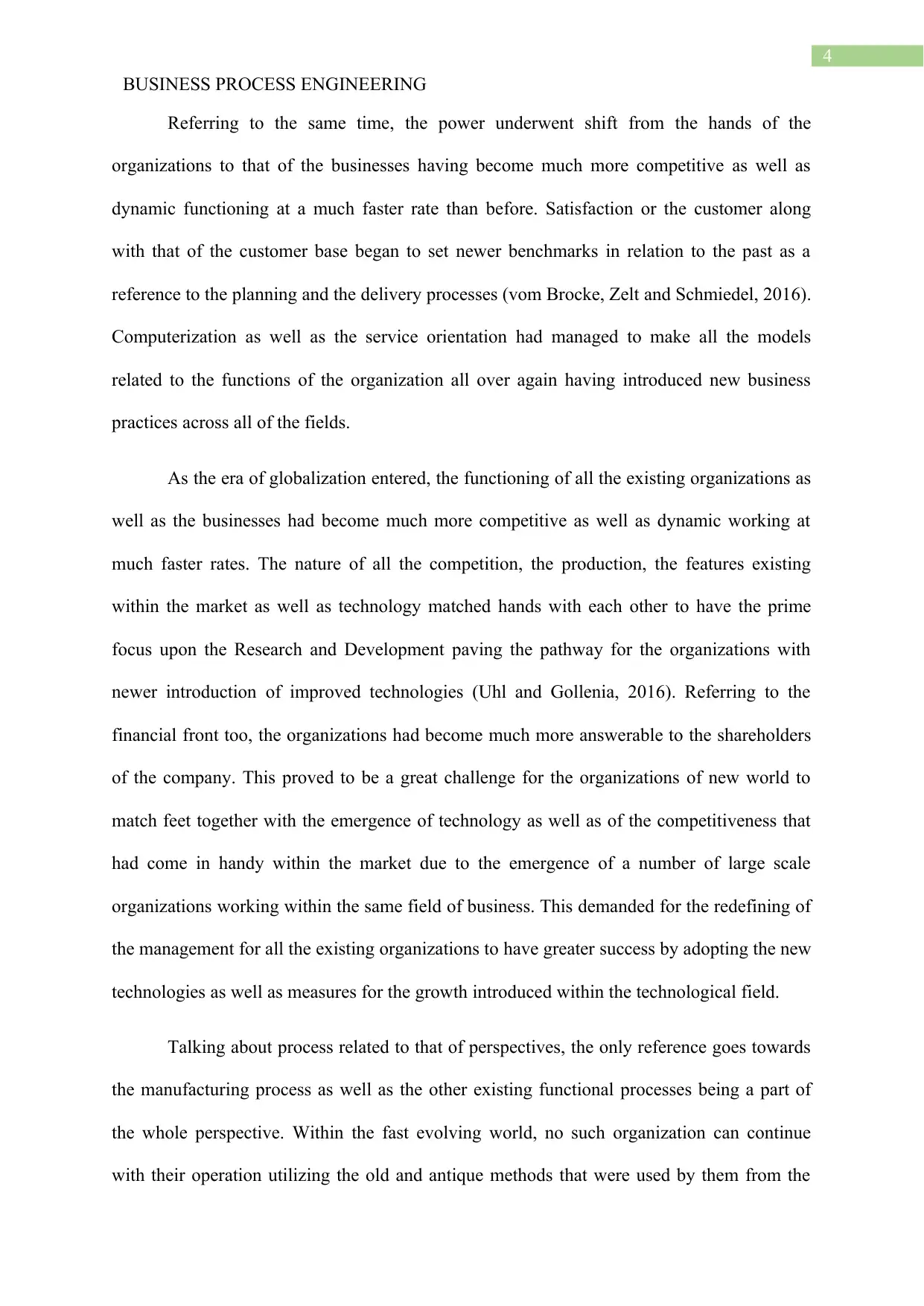
4
BUSINESS PROCESS ENGINEERING
Referring to the same time, the power underwent shift from the hands of the
organizations to that of the businesses having become much more competitive as well as
dynamic functioning at a much faster rate than before. Satisfaction or the customer along
with that of the customer base began to set newer benchmarks in relation to the past as a
reference to the planning and the delivery processes (vom Brocke, Zelt and Schmiedel, 2016).
Computerization as well as the service orientation had managed to make all the models
related to the functions of the organization all over again having introduced new business
practices across all of the fields.
As the era of globalization entered, the functioning of all the existing organizations as
well as the businesses had become much more competitive as well as dynamic working at
much faster rates. The nature of all the competition, the production, the features existing
within the market as well as technology matched hands with each other to have the prime
focus upon the Research and Development paving the pathway for the organizations with
newer introduction of improved technologies (Uhl and Gollenia, 2016). Referring to the
financial front too, the organizations had become much more answerable to the shareholders
of the company. This proved to be a great challenge for the organizations of new world to
match feet together with the emergence of technology as well as of the competitiveness that
had come in handy within the market due to the emergence of a number of large scale
organizations working within the same field of business. This demanded for the redefining of
the management for all the existing organizations to have greater success by adopting the new
technologies as well as measures for the growth introduced within the technological field.
Talking about process related to that of perspectives, the only reference goes towards
the manufacturing process as well as the other existing functional processes being a part of
the whole perspective. Within the fast evolving world, no such organization can continue
with their operation utilizing the old and antique methods that were used by them from the
BUSINESS PROCESS ENGINEERING
Referring to the same time, the power underwent shift from the hands of the
organizations to that of the businesses having become much more competitive as well as
dynamic functioning at a much faster rate than before. Satisfaction or the customer along
with that of the customer base began to set newer benchmarks in relation to the past as a
reference to the planning and the delivery processes (vom Brocke, Zelt and Schmiedel, 2016).
Computerization as well as the service orientation had managed to make all the models
related to the functions of the organization all over again having introduced new business
practices across all of the fields.
As the era of globalization entered, the functioning of all the existing organizations as
well as the businesses had become much more competitive as well as dynamic working at
much faster rates. The nature of all the competition, the production, the features existing
within the market as well as technology matched hands with each other to have the prime
focus upon the Research and Development paving the pathway for the organizations with
newer introduction of improved technologies (Uhl and Gollenia, 2016). Referring to the
financial front too, the organizations had become much more answerable to the shareholders
of the company. This proved to be a great challenge for the organizations of new world to
match feet together with the emergence of technology as well as of the competitiveness that
had come in handy within the market due to the emergence of a number of large scale
organizations working within the same field of business. This demanded for the redefining of
the management for all the existing organizations to have greater success by adopting the new
technologies as well as measures for the growth introduced within the technological field.
Talking about process related to that of perspectives, the only reference goes towards
the manufacturing process as well as the other existing functional processes being a part of
the whole perspective. Within the fast evolving world, no such organization can continue
with their operation utilizing the old and antique methods that were used by them from the
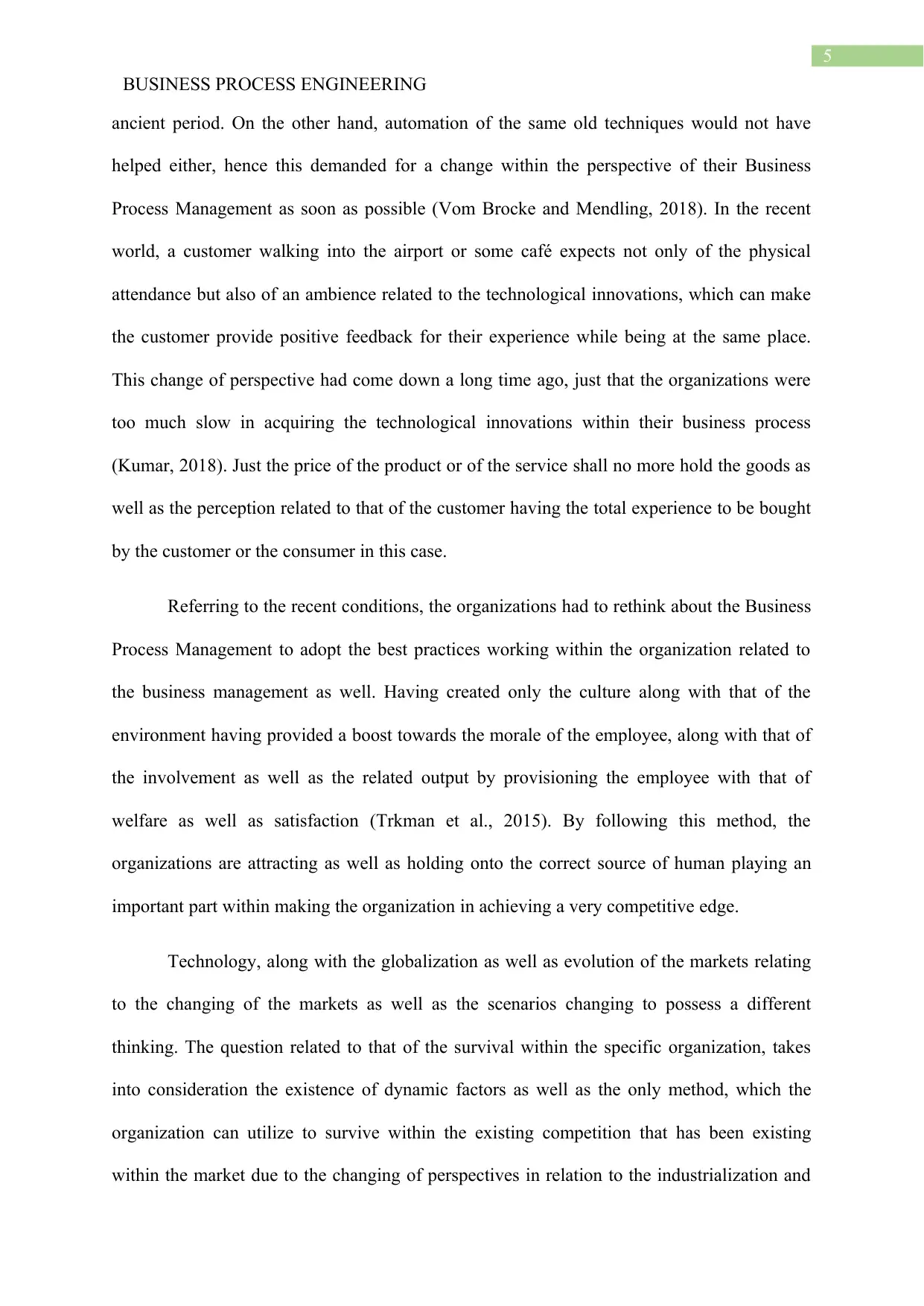
5
BUSINESS PROCESS ENGINEERING
ancient period. On the other hand, automation of the same old techniques would not have
helped either, hence this demanded for a change within the perspective of their Business
Process Management as soon as possible (Vom Brocke and Mendling, 2018). In the recent
world, a customer walking into the airport or some café expects not only of the physical
attendance but also of an ambience related to the technological innovations, which can make
the customer provide positive feedback for their experience while being at the same place.
This change of perspective had come down a long time ago, just that the organizations were
too much slow in acquiring the technological innovations within their business process
(Kumar, 2018). Just the price of the product or of the service shall no more hold the goods as
well as the perception related to that of the customer having the total experience to be bought
by the customer or the consumer in this case.
Referring to the recent conditions, the organizations had to rethink about the Business
Process Management to adopt the best practices working within the organization related to
the business management as well. Having created only the culture along with that of the
environment having provided a boost towards the morale of the employee, along with that of
the involvement as well as the related output by provisioning the employee with that of
welfare as well as satisfaction (Trkman et al., 2015). By following this method, the
organizations are attracting as well as holding onto the correct source of human playing an
important part within making the organization in achieving a very competitive edge.
Technology, along with the globalization as well as evolution of the markets relating
to the changing of the markets as well as the scenarios changing to possess a different
thinking. The question related to that of the survival within the specific organization, takes
into consideration the existence of dynamic factors as well as the only method, which the
organization can utilize to survive within the existing competition that has been existing
within the market due to the changing of perspectives in relation to the industrialization and
BUSINESS PROCESS ENGINEERING
ancient period. On the other hand, automation of the same old techniques would not have
helped either, hence this demanded for a change within the perspective of their Business
Process Management as soon as possible (Vom Brocke and Mendling, 2018). In the recent
world, a customer walking into the airport or some café expects not only of the physical
attendance but also of an ambience related to the technological innovations, which can make
the customer provide positive feedback for their experience while being at the same place.
This change of perspective had come down a long time ago, just that the organizations were
too much slow in acquiring the technological innovations within their business process
(Kumar, 2018). Just the price of the product or of the service shall no more hold the goods as
well as the perception related to that of the customer having the total experience to be bought
by the customer or the consumer in this case.
Referring to the recent conditions, the organizations had to rethink about the Business
Process Management to adopt the best practices working within the organization related to
the business management as well. Having created only the culture along with that of the
environment having provided a boost towards the morale of the employee, along with that of
the involvement as well as the related output by provisioning the employee with that of
welfare as well as satisfaction (Trkman et al., 2015). By following this method, the
organizations are attracting as well as holding onto the correct source of human playing an
important part within making the organization in achieving a very competitive edge.
Technology, along with the globalization as well as evolution of the markets relating
to the changing of the markets as well as the scenarios changing to possess a different
thinking. The question related to that of the survival within the specific organization, takes
into consideration the existence of dynamic factors as well as the only method, which the
organization can utilize to survive within the existing competition that has been existing
within the market due to the changing of perspectives in relation to the industrialization and
⊘ This is a preview!⊘
Do you want full access?
Subscribe today to unlock all pages.

Trusted by 1+ million students worldwide
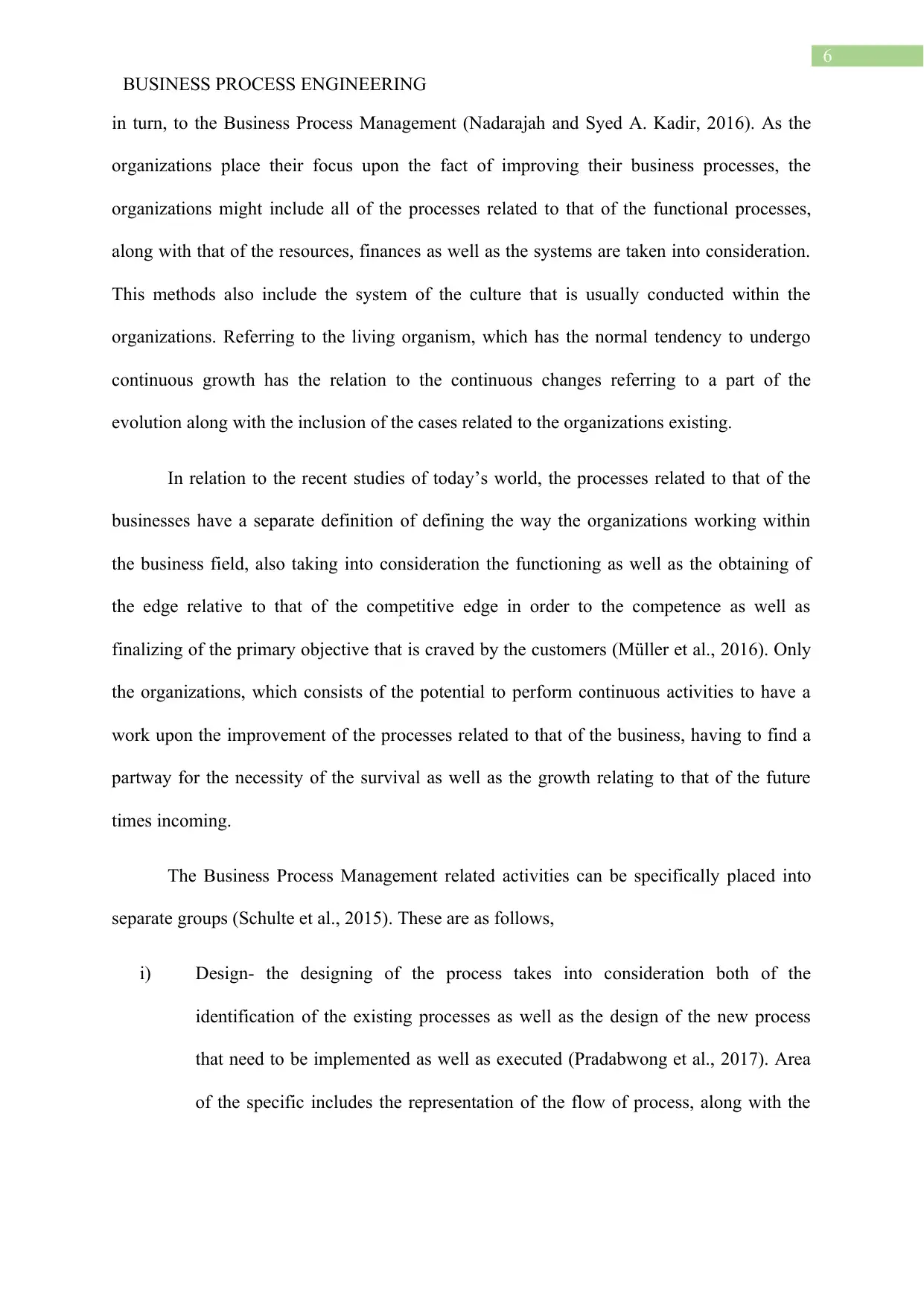
6
BUSINESS PROCESS ENGINEERING
in turn, to the Business Process Management (Nadarajah and Syed A. Kadir, 2016). As the
organizations place their focus upon the fact of improving their business processes, the
organizations might include all of the processes related to that of the functional processes,
along with that of the resources, finances as well as the systems are taken into consideration.
This methods also include the system of the culture that is usually conducted within the
organizations. Referring to the living organism, which has the normal tendency to undergo
continuous growth has the relation to the continuous changes referring to a part of the
evolution along with the inclusion of the cases related to the organizations existing.
In relation to the recent studies of today’s world, the processes related to that of the
businesses have a separate definition of defining the way the organizations working within
the business field, also taking into consideration the functioning as well as the obtaining of
the edge relative to that of the competitive edge in order to the competence as well as
finalizing of the primary objective that is craved by the customers (Müller et al., 2016). Only
the organizations, which consists of the potential to perform continuous activities to have a
work upon the improvement of the processes related to that of the business, having to find a
partway for the necessity of the survival as well as the growth relating to that of the future
times incoming.
The Business Process Management related activities can be specifically placed into
separate groups (Schulte et al., 2015). These are as follows,
i) Design- the designing of the process takes into consideration both of the
identification of the existing processes as well as the design of the new process
that need to be implemented as well as executed (Pradabwong et al., 2017). Area
of the specific includes the representation of the flow of process, along with the
BUSINESS PROCESS ENGINEERING
in turn, to the Business Process Management (Nadarajah and Syed A. Kadir, 2016). As the
organizations place their focus upon the fact of improving their business processes, the
organizations might include all of the processes related to that of the functional processes,
along with that of the resources, finances as well as the systems are taken into consideration.
This methods also include the system of the culture that is usually conducted within the
organizations. Referring to the living organism, which has the normal tendency to undergo
continuous growth has the relation to the continuous changes referring to a part of the
evolution along with the inclusion of the cases related to the organizations existing.
In relation to the recent studies of today’s world, the processes related to that of the
businesses have a separate definition of defining the way the organizations working within
the business field, also taking into consideration the functioning as well as the obtaining of
the edge relative to that of the competitive edge in order to the competence as well as
finalizing of the primary objective that is craved by the customers (Müller et al., 2016). Only
the organizations, which consists of the potential to perform continuous activities to have a
work upon the improvement of the processes related to that of the business, having to find a
partway for the necessity of the survival as well as the growth relating to that of the future
times incoming.
The Business Process Management related activities can be specifically placed into
separate groups (Schulte et al., 2015). These are as follows,
i) Design- the designing of the process takes into consideration both of the
identification of the existing processes as well as the design of the new process
that need to be implemented as well as executed (Pradabwong et al., 2017). Area
of the specific includes the representation of the flow of process, along with the
Paraphrase This Document
Need a fresh take? Get an instant paraphrase of this document with our AI Paraphraser
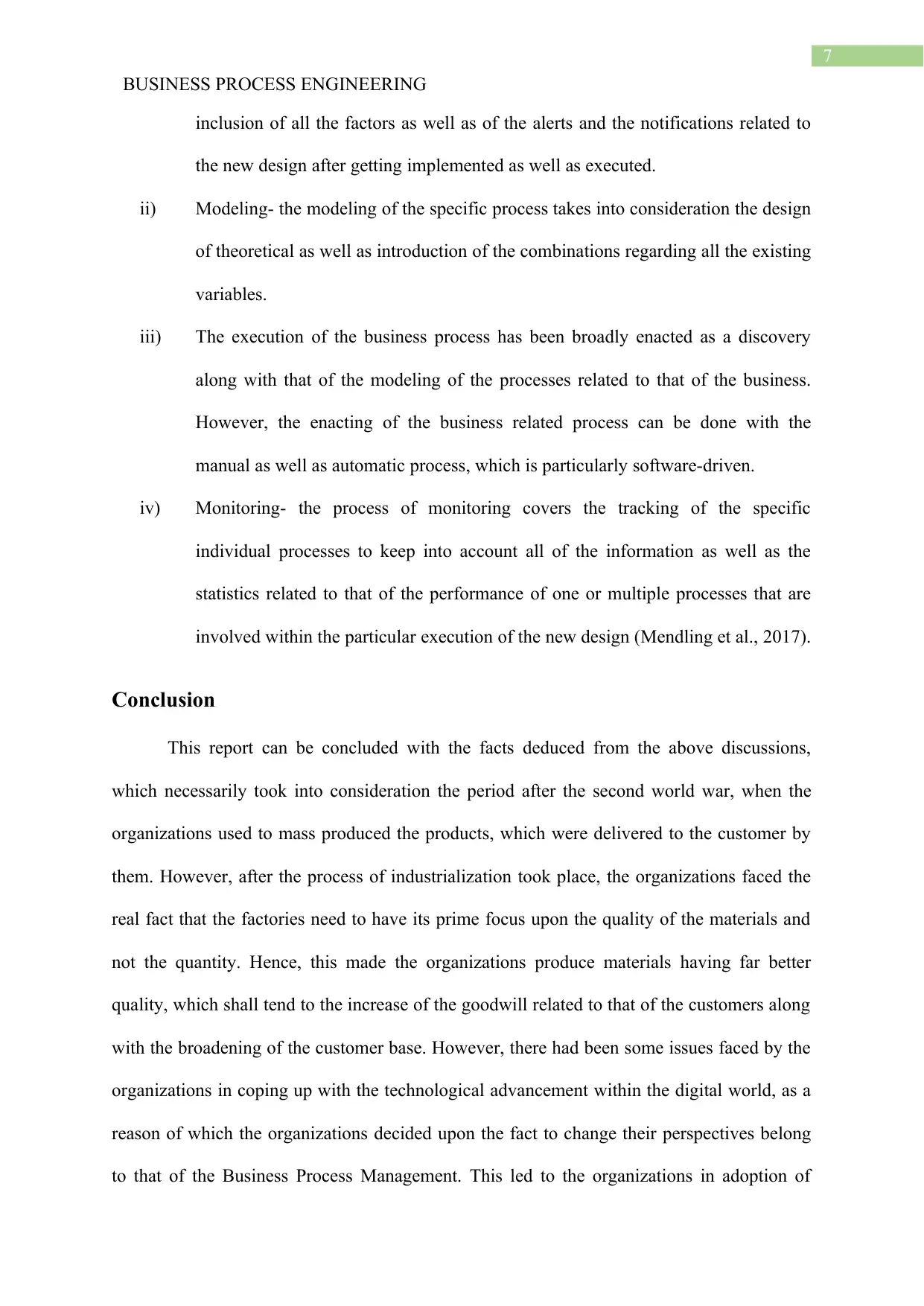
7
BUSINESS PROCESS ENGINEERING
inclusion of all the factors as well as of the alerts and the notifications related to
the new design after getting implemented as well as executed.
ii) Modeling- the modeling of the specific process takes into consideration the design
of theoretical as well as introduction of the combinations regarding all the existing
variables.
iii) The execution of the business process has been broadly enacted as a discovery
along with that of the modeling of the processes related to that of the business.
However, the enacting of the business related process can be done with the
manual as well as automatic process, which is particularly software-driven.
iv) Monitoring- the process of monitoring covers the tracking of the specific
individual processes to keep into account all of the information as well as the
statistics related to that of the performance of one or multiple processes that are
involved within the particular execution of the new design (Mendling et al., 2017).
Conclusion
This report can be concluded with the facts deduced from the above discussions,
which necessarily took into consideration the period after the second world war, when the
organizations used to mass produced the products, which were delivered to the customer by
them. However, after the process of industrialization took place, the organizations faced the
real fact that the factories need to have its prime focus upon the quality of the materials and
not the quantity. Hence, this made the organizations produce materials having far better
quality, which shall tend to the increase of the goodwill related to that of the customers along
with the broadening of the customer base. However, there had been some issues faced by the
organizations in coping up with the technological advancement within the digital world, as a
reason of which the organizations decided upon the fact to change their perspectives belong
to that of the Business Process Management. This led to the organizations in adoption of
BUSINESS PROCESS ENGINEERING
inclusion of all the factors as well as of the alerts and the notifications related to
the new design after getting implemented as well as executed.
ii) Modeling- the modeling of the specific process takes into consideration the design
of theoretical as well as introduction of the combinations regarding all the existing
variables.
iii) The execution of the business process has been broadly enacted as a discovery
along with that of the modeling of the processes related to that of the business.
However, the enacting of the business related process can be done with the
manual as well as automatic process, which is particularly software-driven.
iv) Monitoring- the process of monitoring covers the tracking of the specific
individual processes to keep into account all of the information as well as the
statistics related to that of the performance of one or multiple processes that are
involved within the particular execution of the new design (Mendling et al., 2017).
Conclusion
This report can be concluded with the facts deduced from the above discussions,
which necessarily took into consideration the period after the second world war, when the
organizations used to mass produced the products, which were delivered to the customer by
them. However, after the process of industrialization took place, the organizations faced the
real fact that the factories need to have its prime focus upon the quality of the materials and
not the quantity. Hence, this made the organizations produce materials having far better
quality, which shall tend to the increase of the goodwill related to that of the customers along
with the broadening of the customer base. However, there had been some issues faced by the
organizations in coping up with the technological advancement within the digital world, as a
reason of which the organizations decided upon the fact to change their perspectives belong
to that of the Business Process Management. This led to the organizations in adoption of
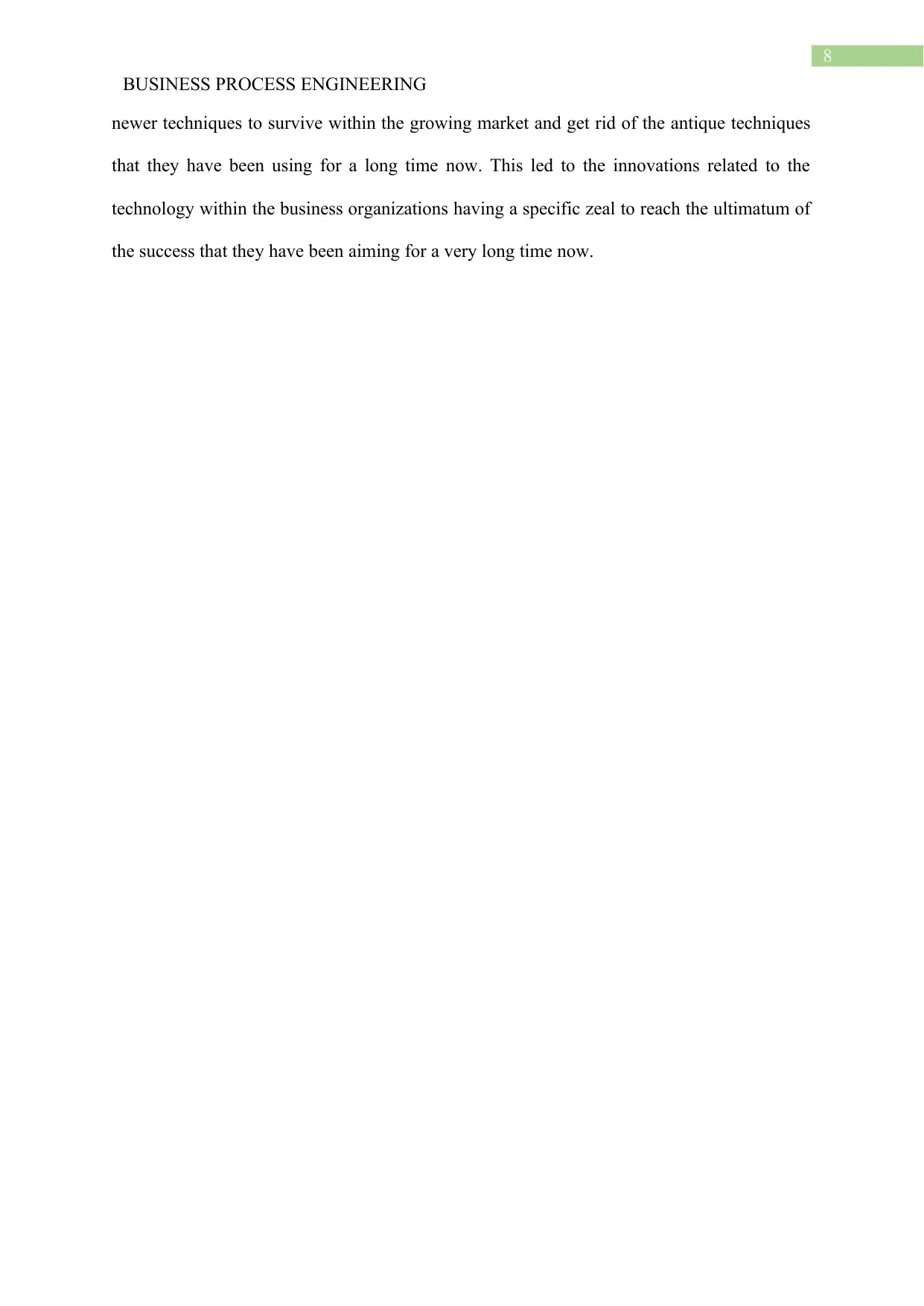
8
BUSINESS PROCESS ENGINEERING
newer techniques to survive within the growing market and get rid of the antique techniques
that they have been using for a long time now. This led to the innovations related to the
technology within the business organizations having a specific zeal to reach the ultimatum of
the success that they have been aiming for a very long time now.
BUSINESS PROCESS ENGINEERING
newer techniques to survive within the growing market and get rid of the antique techniques
that they have been using for a long time now. This led to the innovations related to the
technology within the business organizations having a specific zeal to reach the ultimatum of
the success that they have been aiming for a very long time now.
⊘ This is a preview!⊘
Do you want full access?
Subscribe today to unlock all pages.

Trusted by 1+ million students worldwide
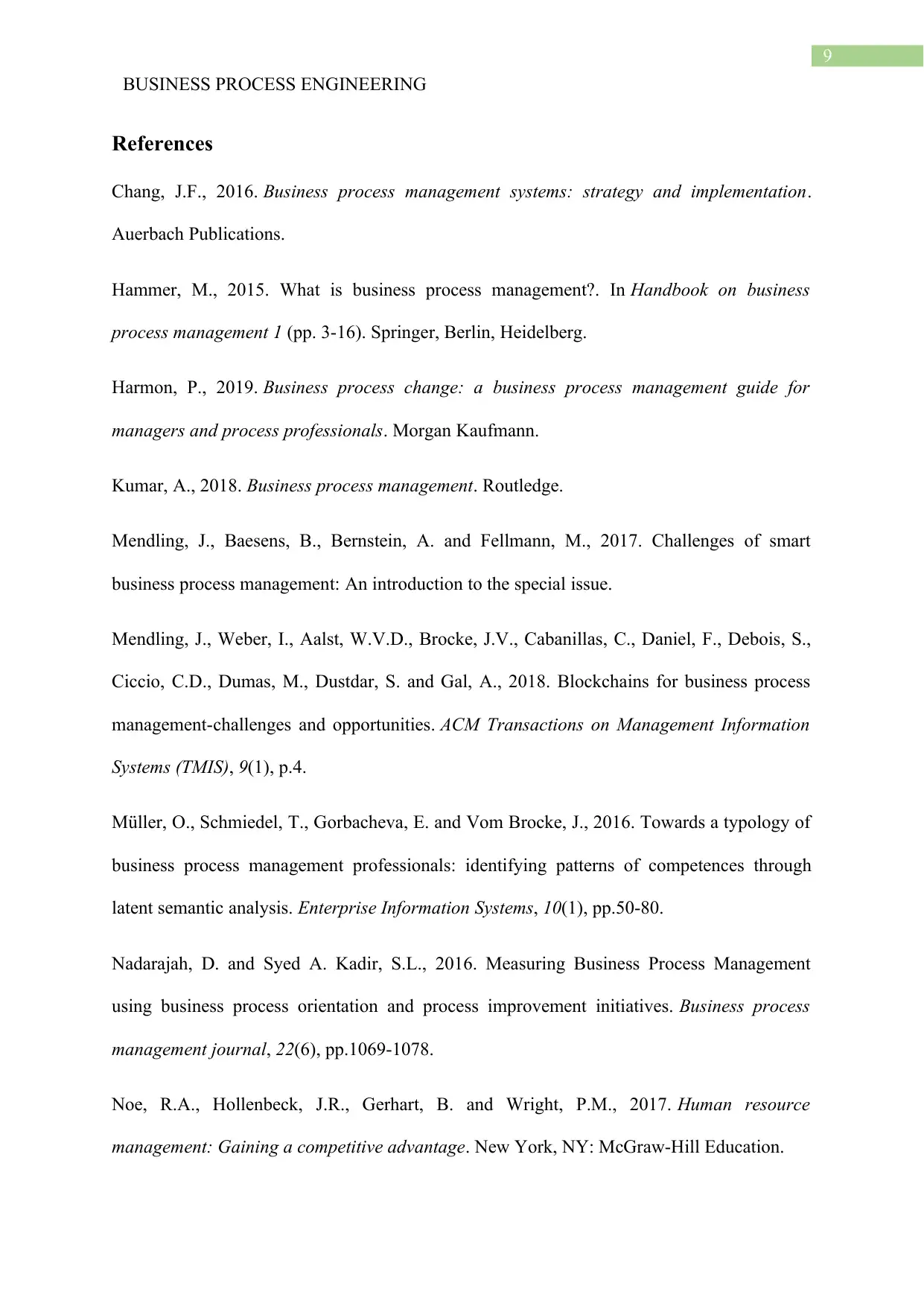
9
BUSINESS PROCESS ENGINEERING
References
Chang, J.F., 2016. Business process management systems: strategy and implementation.
Auerbach Publications.
Hammer, M., 2015. What is business process management?. In Handbook on business
process management 1 (pp. 3-16). Springer, Berlin, Heidelberg.
Harmon, P., 2019. Business process change: a business process management guide for
managers and process professionals. Morgan Kaufmann.
Kumar, A., 2018. Business process management. Routledge.
Mendling, J., Baesens, B., Bernstein, A. and Fellmann, M., 2017. Challenges of smart
business process management: An introduction to the special issue.
Mendling, J., Weber, I., Aalst, W.V.D., Brocke, J.V., Cabanillas, C., Daniel, F., Debois, S.,
Ciccio, C.D., Dumas, M., Dustdar, S. and Gal, A., 2018. Blockchains for business process
management-challenges and opportunities. ACM Transactions on Management Information
Systems (TMIS), 9(1), p.4.
Müller, O., Schmiedel, T., Gorbacheva, E. and Vom Brocke, J., 2016. Towards a typology of
business process management professionals: identifying patterns of competences through
latent semantic analysis. Enterprise Information Systems, 10(1), pp.50-80.
Nadarajah, D. and Syed A. Kadir, S.L., 2016. Measuring Business Process Management
using business process orientation and process improvement initiatives. Business process
management journal, 22(6), pp.1069-1078.
Noe, R.A., Hollenbeck, J.R., Gerhart, B. and Wright, P.M., 2017. Human resource
management: Gaining a competitive advantage. New York, NY: McGraw-Hill Education.
BUSINESS PROCESS ENGINEERING
References
Chang, J.F., 2016. Business process management systems: strategy and implementation.
Auerbach Publications.
Hammer, M., 2015. What is business process management?. In Handbook on business
process management 1 (pp. 3-16). Springer, Berlin, Heidelberg.
Harmon, P., 2019. Business process change: a business process management guide for
managers and process professionals. Morgan Kaufmann.
Kumar, A., 2018. Business process management. Routledge.
Mendling, J., Baesens, B., Bernstein, A. and Fellmann, M., 2017. Challenges of smart
business process management: An introduction to the special issue.
Mendling, J., Weber, I., Aalst, W.V.D., Brocke, J.V., Cabanillas, C., Daniel, F., Debois, S.,
Ciccio, C.D., Dumas, M., Dustdar, S. and Gal, A., 2018. Blockchains for business process
management-challenges and opportunities. ACM Transactions on Management Information
Systems (TMIS), 9(1), p.4.
Müller, O., Schmiedel, T., Gorbacheva, E. and Vom Brocke, J., 2016. Towards a typology of
business process management professionals: identifying patterns of competences through
latent semantic analysis. Enterprise Information Systems, 10(1), pp.50-80.
Nadarajah, D. and Syed A. Kadir, S.L., 2016. Measuring Business Process Management
using business process orientation and process improvement initiatives. Business process
management journal, 22(6), pp.1069-1078.
Noe, R.A., Hollenbeck, J.R., Gerhart, B. and Wright, P.M., 2017. Human resource
management: Gaining a competitive advantage. New York, NY: McGraw-Hill Education.
Paraphrase This Document
Need a fresh take? Get an instant paraphrase of this document with our AI Paraphraser
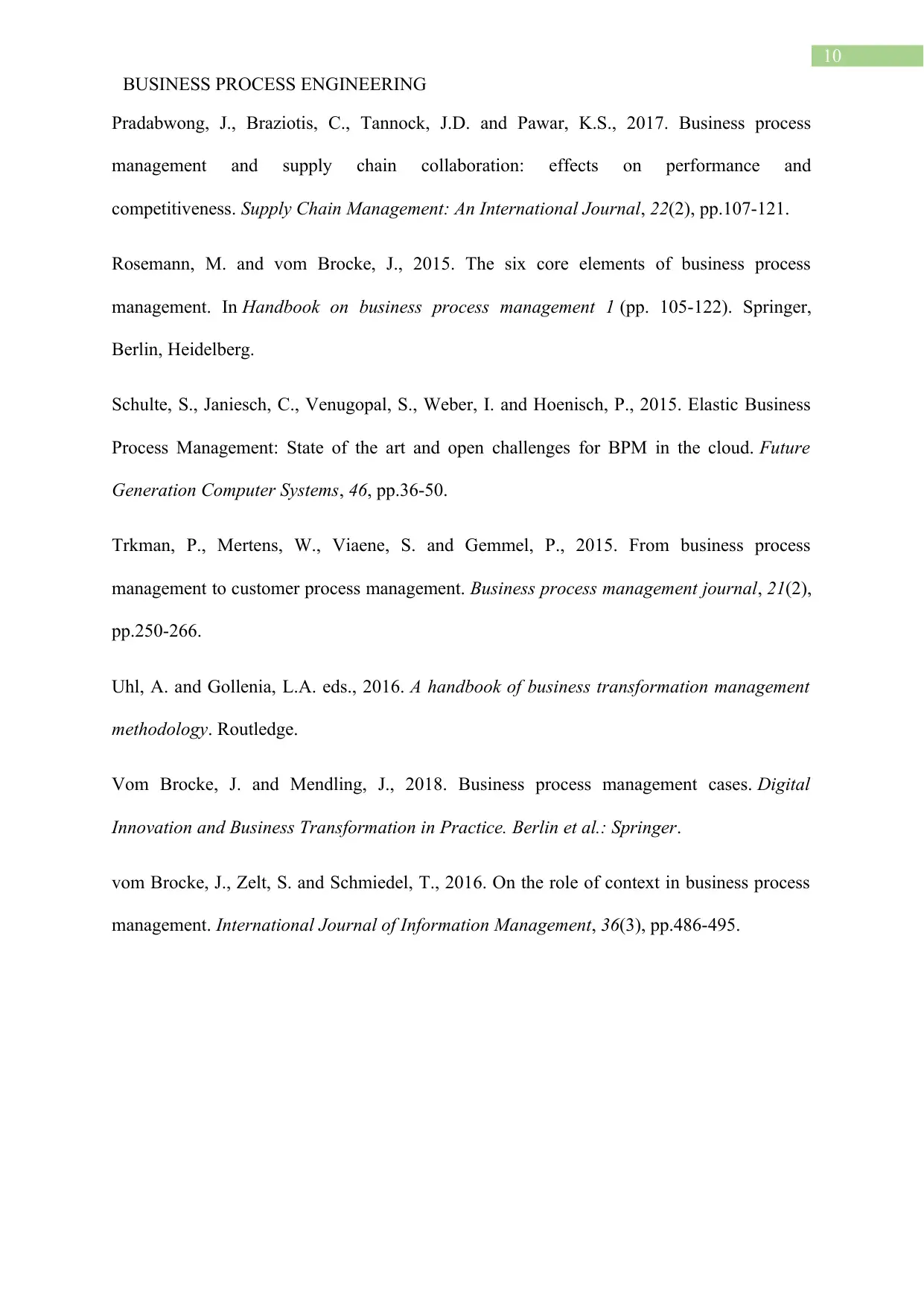
10
BUSINESS PROCESS ENGINEERING
Pradabwong, J., Braziotis, C., Tannock, J.D. and Pawar, K.S., 2017. Business process
management and supply chain collaboration: effects on performance and
competitiveness. Supply Chain Management: An International Journal, 22(2), pp.107-121.
Rosemann, M. and vom Brocke, J., 2015. The six core elements of business process
management. In Handbook on business process management 1 (pp. 105-122). Springer,
Berlin, Heidelberg.
Schulte, S., Janiesch, C., Venugopal, S., Weber, I. and Hoenisch, P., 2015. Elastic Business
Process Management: State of the art and open challenges for BPM in the cloud. Future
Generation Computer Systems, 46, pp.36-50.
Trkman, P., Mertens, W., Viaene, S. and Gemmel, P., 2015. From business process
management to customer process management. Business process management journal, 21(2),
pp.250-266.
Uhl, A. and Gollenia, L.A. eds., 2016. A handbook of business transformation management
methodology. Routledge.
Vom Brocke, J. and Mendling, J., 2018. Business process management cases. Digital
Innovation and Business Transformation in Practice. Berlin et al.: Springer.
vom Brocke, J., Zelt, S. and Schmiedel, T., 2016. On the role of context in business process
management. International Journal of Information Management, 36(3), pp.486-495.
BUSINESS PROCESS ENGINEERING
Pradabwong, J., Braziotis, C., Tannock, J.D. and Pawar, K.S., 2017. Business process
management and supply chain collaboration: effects on performance and
competitiveness. Supply Chain Management: An International Journal, 22(2), pp.107-121.
Rosemann, M. and vom Brocke, J., 2015. The six core elements of business process
management. In Handbook on business process management 1 (pp. 105-122). Springer,
Berlin, Heidelberg.
Schulte, S., Janiesch, C., Venugopal, S., Weber, I. and Hoenisch, P., 2015. Elastic Business
Process Management: State of the art and open challenges for BPM in the cloud. Future
Generation Computer Systems, 46, pp.36-50.
Trkman, P., Mertens, W., Viaene, S. and Gemmel, P., 2015. From business process
management to customer process management. Business process management journal, 21(2),
pp.250-266.
Uhl, A. and Gollenia, L.A. eds., 2016. A handbook of business transformation management
methodology. Routledge.
Vom Brocke, J. and Mendling, J., 2018. Business process management cases. Digital
Innovation and Business Transformation in Practice. Berlin et al.: Springer.
vom Brocke, J., Zelt, S. and Schmiedel, T., 2016. On the role of context in business process
management. International Journal of Information Management, 36(3), pp.486-495.
1 out of 11
Related Documents
Your All-in-One AI-Powered Toolkit for Academic Success.
+13062052269
info@desklib.com
Available 24*7 on WhatsApp / Email
![[object Object]](/_next/static/media/star-bottom.7253800d.svg)
Unlock your academic potential
Copyright © 2020–2025 A2Z Services. All Rights Reserved. Developed and managed by ZUCOL.





